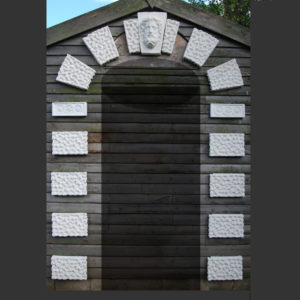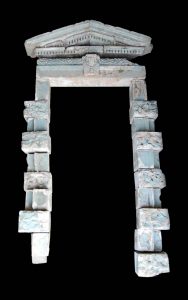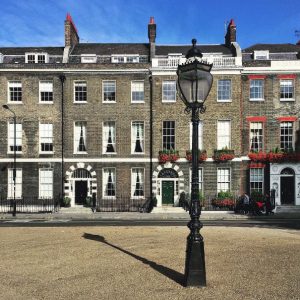No products in the basket.
13th October 2015
The Vermiculated Rustications of Bedford Square
We are delighted to be able to now offer for sale accurate castings of the landmark door surrounds of Bedford Square. They have been carefully cast by our resident Master Plaster Caster, Mr Peter Hone, from one of the Georgian originals in New Cavendish Street. (Available here ).
In summarising the story behind the striking door surrounds of Bedford Square – the vermiculated* quoins by Coade – we simply can not do better than quote Andrew Byrne at length. His book “Bedford Square – An architectural study” Athlone Press 1990, covers all aspects of the remarkable Bloomsbury square in some detail:
“The most striking embellishment of the plain brick houses of [Bedford] Square is their conspicuous doorways. The semi-circular openings are framed with large vermiculated blocks and voussoirs, imposts and keystones all of which are artificial stone. This is Coade stone that came from the Coade Lithodipyra, Terra-cotta or Artificial stone Manufactory, established on the Thames-side at Narrow Wall, Lambeth in 1769.
Coade stone proved itself to be one of the great building materials of the Georgian era after its introduction in the 1760’s. Far from being seen as an inferior substitute for more expensive natural stone, it was taken up by virtually all the leading architects. Sir William Chambers used it for the parapet vases at Somerset House, Robert Adam used it at No.20 Portman Square, James Wyatt decorated the front of his house in Foley Place with it and, just around the corner, some forty years later, John Nash used it for the Ionic capitals of the portico, and the Corinthian capitals of the drum tower, of his church of All Souls, Langham Place which was otherwise constructed of Bath Stone.”

A quick tangent!: It so happens that we have in stock at LASSCO Three Pigeons what could be an important part of this story. William Chambers, prior to building Somerset House, built a grand Georgian terrace in Berners Street, Fitzrovia. Slighty prior to Adam’s influence, each house there had a, (“bulky”! – see below), architectural door surround in the Palladian style with carved stone rusticated quoins. The central house of the range was for Chambers himself and the entablature of that doorcase was centred with a Coade Stone keystone. This is the doorcase we have for sale. We know that the project was completed in 1769 – the year that the Coade stone kilns were first fired up in Lambeth – so we could, in our Chambers doorcase, have one of the first applications of Coade stone keystones in London doorcases – a practice that reached its zenith in Bloomsbury a few years later.

Anyway, back to Mr Byrne’s account of the use of Coade Stone at Bedford Square:
“Its repetitive use at Bedford Square typifies the healthy attitude towards standardisation and mass production in an age obsessed with good taste. It is difficult to pinpoint the reason why this type of doorway was produced by Coade and used so extensively at Bedford Square and then in so many parts of London, but the 1774 Building Act certainly had a lot to do with its subsequent popularity. The bulky Palladian doorcase was already long since out of fashion by the year the Act was drafted, ousted by the more delicate doorways of the Adam school. The Act firmly reinforced the demand for this type of doorway although it did not, as is commonly thought, completely ban woodwork from the fronts of the houses. While it decreed that there should be no external wooden decoration, it made exceptions, one of which was for frontispieces to doorways of houses of the Second, Third and Fourth Rates. The houses in the square, all of the First Rate, therefore required something other than wood, and what better than the successful new artificial stone from Lambeth.”
“The Coade Stone doorways in Bedford Square are probably the earliest surviving examples of their type in London, a type that was promoted by Coade and used all over the country, but particularly in the capital. There are good examples, all later than Bedford Square, at Thurston House in Rectory Grove, Clapham and at No.7 Nightingale Lane on the west side of Clapham Common, in Baker Street, Harley Street, New Cavendish Street and Clarges Street in the West End, and more modest examples in Kennington Park Road and New Road, Whitechapel. There is an example on the side doorway of a house in Camberwell Green and also in Charterhouse Square, Clerkenwell. In Exeter they can be seen decorating the fine houses in Southernhay. All these examples date to within about forty years of their appearance in Bloomsbury.”
“While Portland stone has weathered, Coade Stone remains as intact as the day it left Lambeth. This was something certainly not lost on the proprietors, as they pointed out in their 1784 catalogue; “The property which this artificial has above natural stone, of resisting the frost, and consequently on retaining that sharpness in which it excels every kind of Stone Sculpture, renders it particularly fit for statues in parks and gardens, also for tombs and monuments in the church yards of this, or a severer climate.”
The rusticated quoins were still on offer from Coade at the end of the century, appearing in their catalogue as “Rustic Frontispieces for Doorways, Guilloche Fascia etc.”. LASSCO is very happy to revive the supply, with the various quoins being available individually, as in Eleanor Coade’s day, in order they can be applied to any suitable door surround to add a distinctive edge with a peerless provenance.

Please contact Tom, Kim or Ant at LASSCO Three Pigeons for more information: 3pigeons@lassco.co.uk
*Vermiculated:
vermiculated
vəˈmɪkjʊleɪtɪd/
adjective – derived from Latin for “worm”
adjective: vermiculated
1.
(especially of the plumage of a bird) marked with sinuous or wavy lines.
2.
archaic
worm-eaten.
